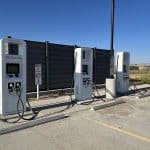If you use a car or truck in your business in the US, the IRS has rules (of course). Here’s some highlights:
Deductible Car and Truck Expenses
What qualifies?
- Traveling from one work location to another within the taxpayer’s tax home area. (Generally, the tax home is the entire city or general area where the taxpayer’s main place of business is located, regardless of where he or she resides.)
- Visiting customers.
- Attending a business meeting away from the regular workplace.
- Getting from home to a temporary workplace when the taxpayer has one or more regular places of work. (These temporary workplaces can be either within or outside taxpayer’s tax home area.)
It is important to note that costs related to travel between a taxpayer’s home and regular place of work are commuting expenses and are not deductible.
Taxpayers can choose to use either the standard mileage rate or actual expenses to compute their allowable business deduction. They may want to figure the deduction using both methods to see which provides a larger deduction.
Standard Mileage Rate MethodThe standard mileage rate may be used to figure the deductible costs of a vehicle that is owned or leased. If a taxpayer wishes to use the standard mileage rate for a leased vehicle, it must be used for the entire lease period. In other words, a taxpayer must use the standard mileage rate for the first year a vehicle is available for business use in order to use the standard mileage rate in subsequent years.
The standard mileage rate is adjusted annually by the IRS to reflect changes in the cost of operating a vehicle. In some situations it is adjusted during the year. The 2006 standard mileage rate of 44.5 cents per mile, as well as rates for previous periods, can be found at the IRS site.
The standard mileage rate is used in place of actual expenses. Taxpayers who choose the standard mileage rate may not deduct actual expenses, such as depreciation, lease payments, maintenance and repairs, gasoline (including gasoline taxes), oil, insurance or vehicle registration fees. Business-related parking fees and tolls may be deducted in addition to the standard mileage rate. Fees for parking at a taxpayer’s main place of business or tolls related to commuting to and from that main place of business are personal expenses which are not deductible.
The standard mileage rate cannot be used if the taxpayer:
- Uses the car for hire (such as a taxi).
- Uses five or more cars at the same time (as in fleet operations).
- Claims depreciation or a section 179 deduction (Publication 463, Chapter 4).
- Is a rural mail carrier who receives a qualified reimbursement (Publication 463, Chapter 4).
Actual Expenses Method
Actual car or truck expenses include:
- Depreciation
- Lease payments
- Registration fees
- Licenses
- Gas
- Insurance
- Repairs
- Oil
- Garage rent
- Tires
- Tolls
- Parking fees
Recordkeeping
It is important to keep complete records to substantiate items reported on a tax return. In the case of car and truck expenses, the types of records required depend on whether the taxpayer claims the standard mileage rate or actual expenses.
To claim the standard mileage rate, appropriate records would include documentation identifying the vehicle and proving ownership or a lease and a daily log showing miles traveled, destination and business purpose.
For actual expenses, a mileage log helps establish business use percentage. Taxpayers should also retain receipts, invoices and other documentation to show cost and establish the identity of the vehicle for which the expense was incurred. For depreciation purposes they need to show the original cost of the vehicle and any improvements as well as the date it was placed in service.
FS-2006-26, October 2006
small biz rural entrepreneurship IRS taxes
New to SmallBizSurvival.com? Take the Guided Tour. Like what you see? Subscribe.










